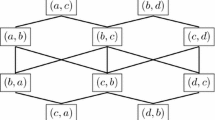Abstract.
We prove the existence of a social choice function implementable via backward induction which always selects within the ultimate uncovered set. Whereas the uncovered set is the set of maximal elements of the covering relation, the ultimate uncovered set is the set obtained by iterative application of this covering operation. Dutta and Sen (1993) showed that any social choice function which is the solution of a generalized binary voting procedure is implementable via backward induction. Our result follows from Dutta and Sen's theorem, in that we construct a binary voting procedure always selecting within the ultimate uncovered set. We use the classical multistage elimination procedure, which always selects an alternative within the uncovered set. When this procedure is also used to select among all of the possible agendas or orderings of alternatives within the procedure, the alternative selected (from the agenda selected) will be within the uncovered set of the uncovered set. Our result follows from repeated application of this construction. Intuitively, the procedure constructed consists of requiring agents to vote on how they should vote and so on.
Similar content being viewed by others
Author information
Authors and Affiliations
Additional information
Received: 7 April 1997 / Accepted: 15 October 1998
Rights and permissions
About this article
Cite this article
Coughlan, P., Le Breton, M. A social choice function implementable via backward induction with values in the ultimate uncovered set. Rev Econ Design 4, 153–160 (1999). https://doi.org/10.1007/s100580050030
Issue Date:
DOI: https://doi.org/10.1007/s100580050030




